Regular blog readers will remember that we moved to my childhood home a few years ago. With an acre or so of landscape I finally have enough room to put in a vegetable garden. My husband built a wonderful raised bed system, complete with critter fencing, and we’ve been enjoying the fresh greens and the first few tomatoes of the season.

We filled these raised beds with native soil. During a porch addition I asked the contractor to stockpile the topsoil near the raised beds. The house was built almost 100 years ago and at that time there were no “designed topsoils” (thank goodness) – soil was simply moved around during construction. Some of this soil had been covered by pavers and the rest had been covered with turf. [You can read more about designed topsoils in this publication under “choosing soil for raised beds.”] There had been no addition of nutrients for at least 7 years so I was confident that this was about as natural a soil as I could expect.
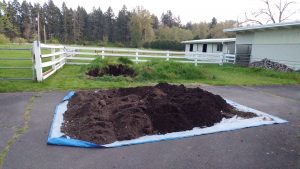
I’ve always advised gardeners to have a soil test done whenever they embark on a new garden or landscape project, so before I added anything to my raised beds I took samples and sent them to the soil testing lab at University of Massachusetts at Amherst (my go-to lab as there are no longer any university labs in Washington State for the public to use).
What I already knew about our soil was that it’s a glacial till (in other words it’s full of rocks left behind by a receding glacier). The area is full of native Garry oak (Quercus garryana), some of which are centuries old. The soil is excessively drained, meaning it’s probably a sandy loam. And that’s about all I knew until my results came back.

Because nothing has been added to this soil for several years, and because I had removed all of the turf grass before filling the beds, I assumed that the organic matter (OM) would be quite low. Most soils that support tree growth have around 3-7% OM. Hah! Ours was over 12%! All I can figure is that centuries of leaf litter has created a rich organic soil.
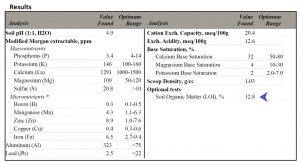
So here’s lesson number one: Don’t add OM just because you think you need it. Too much OM creates overly rich conditions that can reduce the natural protective chemicals in vegetation. This means pests and diseases are more likely to be problems.
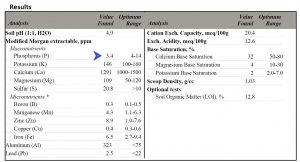
I was pleased to see our P level was low. First soil test I’ve ever seen in my area where P was below the desirable range! Does that mean I’m adding P? No – because there is no evidence of a P deficiency anywhere in the landscape. And my garden plants are growing just fine without it.
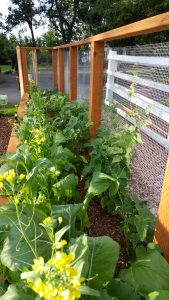
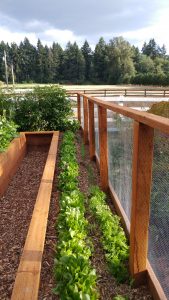
Lesson number two: Just because a nutrient is reportedly deficient, look for evidence of that deficiency before you add it. It’s a lot easier to add something than it is to remove it.
 Likewise, our other nutrient values are just fine, and I was pleased to see that lead levels were low. Given that this is an older house that had lead paint at one time, and given the fact that the soil being tested was adjacent to the house, I was prepared for lead problems.
Likewise, our other nutrient values are just fine, and I was pleased to see that lead levels were low. Given that this is an older house that had lead paint at one time, and given the fact that the soil being tested was adjacent to the house, I was prepared for lead problems.
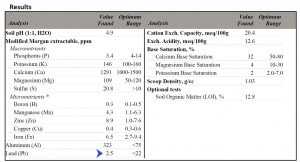
However – we do have high aluminum in the soil. Exactly why…I don’t know. Perhaps the soil is naturally high in aluminum? There’s no evidence that aluminum sulfate or another amendment was ever used. In any case, that was an unexpected result that does give us some concern for root crops. I’ll be doing some research to see what vegetables accumulate aluminum.
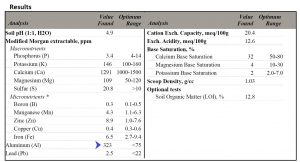
Finally, note our pH – 4.9! This is completely normal for our area, which is naturally acidic. In addition, the tannic acid accumulation from centuries of oak leaves has undoubtedly pushed the pH even lower. Are we going to adjust it? Again, no. There is no evidence of any plant problems, and even our lawn is green. Why would we adjust the pH if there is no visual evidence to support that?
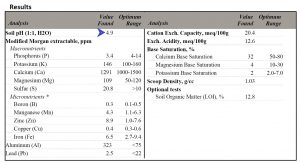
Which leads to lesson number three: Don’t adjust your soil pH just because you think you should. If your plants are growing well, the pH is fine. Plants and their associated root microbes are pretty well adapted to obtaining the necessary nutrients. If you have problems, don’t assume it’s a pH issue. Correlation does not equal causation! You’ll need to eliminate all other possibilities before attempting to change your soil chemistry. And remember it is impossible to permanently change soil pH over the short term. Permanent pH changes require decades, if not centuries of annual inputs (like our oak leaves).
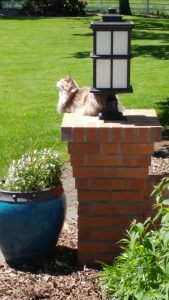
Will I test my soil again? Probably not. I have the baseline report and since I don’t plan to add anything I don’t expect it to change much. If I had a nutrient toxicity I would retest until the level of that nutrient had decreased to normal levels. But with everything growing well, from lawn to vegetables to shrubs and trees, there really is nothing to be concerned about.

Lesson number four: Unless you have something in your soil to worry about, don’t.
Glad your gardens are growing well, Linda. One comment regarding the “mystery” of the high aluminum values. It will be directly linked to the low soil pH, as aluminum solubility from soil minerals increases rapidly below a pH of 5 to 5.5. If you are concerned about aluminum toxicity, a moderate addition of lime may be in order.
All of the soils in the western (wet) part of Washington are acidic. This is the first time I’ve seen a test in this region (and I’ve seen humdreds) where aluminum is so high. It is not typical. We also have relatively low clay content, so not a lot for Al to bind to.
Linda, your vegetable garden looks great! You mentioned not adding any P whatsoever. So you don’t fertilise at all, not even before a new season after last year’s plants have sucked up what’s in the soil?
Thanks Lukas! This is the first year I’ve had the garden. The crop you see is what I got with the unmodified soil, and none of the plants has any signs of any deficiency. Over the winter I’ll keep the soil topdressed with wood chips to keep weeds down and to provide a slow feed of nutrients. I don’t plan to add anything unless I can see a deficiency in the next season.
Lisa- I’m curious what type of wood you used for the framing?
Hi Al, I’m assuming you mean me? The timbers are pressure-treated wood – the newer preservatives are copper based. When I re-do soil tests at some point I’ll pay close attention to the copper level in the soil (which right now is in the optimal range. If it becomes a problem I will re-think my use of these timbers. But right now evidence points to no real problem to plant or people health.
Thanks! Sorry about misspelling your name!
No problem!
Dr. Linda: “I’ll be doing some research to see what vegetables accumulate aluminum”
from reading many posts on Garden Professors blog, i thought the concept of “dynamic accumulators” was debunked.
We’re not talking about “dynamic accumulators” which is not science. We’re talking about the ability of plants to take up metals – many of which are necessary enzymatic cofactors and some of which are toxic metals. Some plants avoid uptake; others take up and accumulate in their roots or leaves. It’s different for every plant. There is a lot of research on heavy metal uptake by vegetables and that’s the literature I look at.
Is there a name for that process?
Not really, other than mineral uptake. All plants do it.
i’m now trying to understand the difference between “mineral uptake” in all plants and the claim that certain plants are “dynamic accumulators”. is it the claim made that minerals are “stored” in the plant?
“Dynamic accumulators” isn’t a scientific term. It’s a belief that certain plants can have deeper roots/accumulate more minerals than other species. It’s not true. It has to do with soil aeration, hydration, nutrient levels, and microbes. Period.
so if you planted lots of hydrangeas, would your soil’s aluminium levels go down?
Not that much! (And I love hydrangeas but I don’t want a monocultural landscape.)
There are probably lots of plants that accumulate aluminum, particularly those that contain this pigment system. Aluminum is required for the color.
This fact sheet discusses the science. https://www.researchgate.net/publication/335925028_HOW_ARE_HYDRANGEA_FLOWER_COLORS_DETERMINED
The article says too much O.M. is not good. How much is too much?
Recommended levels for home gardens and landscapes are around 3-7%. The easiest thing to do is find out what the normal OM levels for your area’s natural soils are. You can find these from soil maps made decades ago. That will tell you what your area’s soils naturally produce in terms of OM. You should aim for the same. When you have too much, you will see excessive levels of nutrients across the board.
Hi Linda et al,
The link you have going to “designed soils” publication is a dead link. Is there a new one?
Thanks for catching that! It’s been updated now.